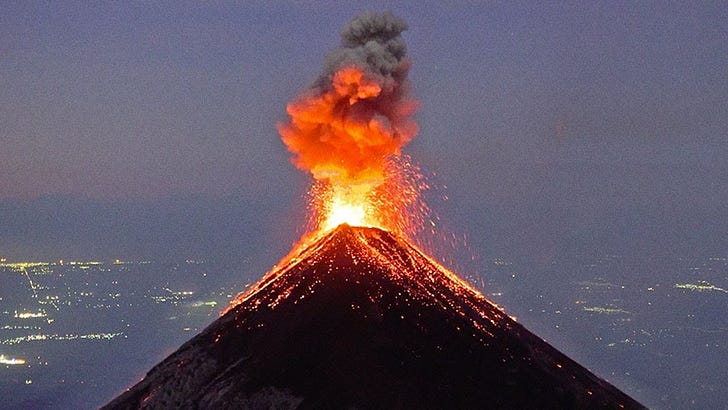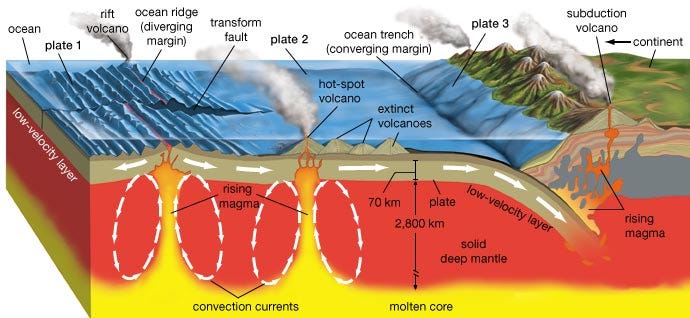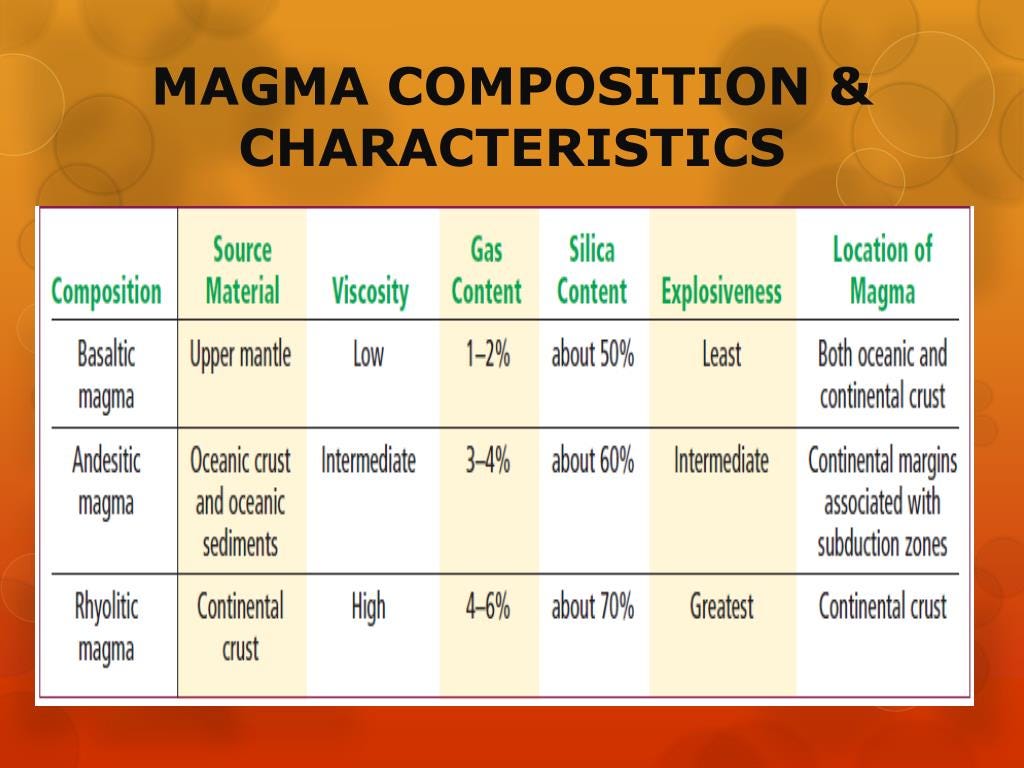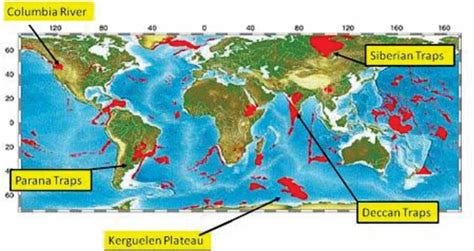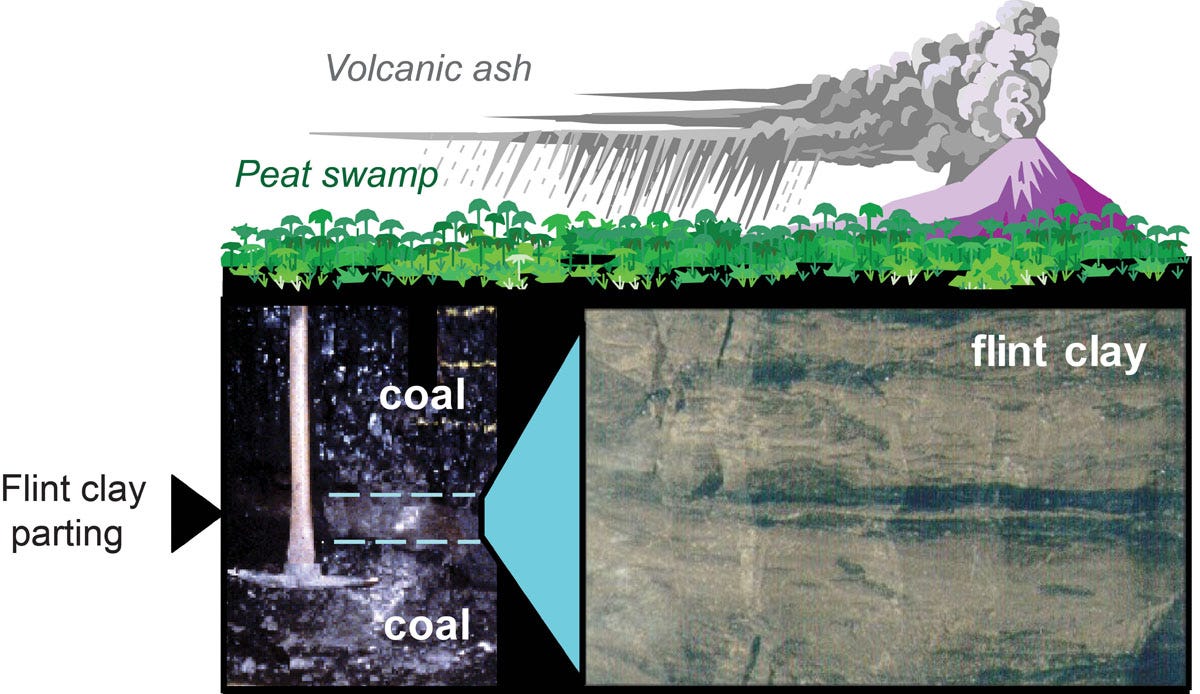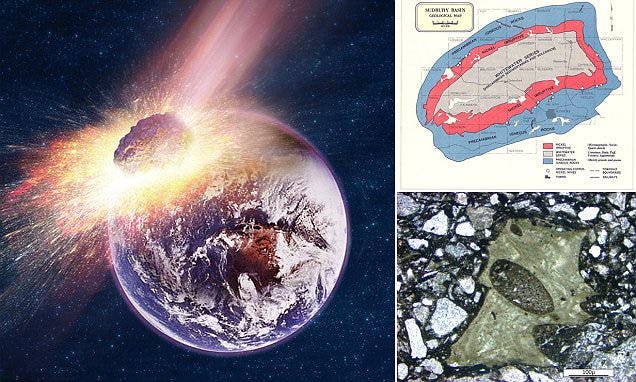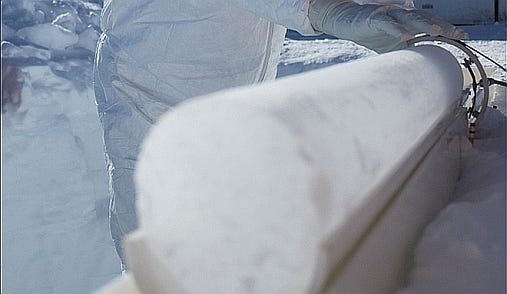CONTENTS
I. VOLCANISM
II. MAGMA COMPOSITION & TECTONIC SETTINGS
III. SUPERVOLCANOES
IV. FLOOD BASALTS, LARGE IGNEOUS PROVINCES
V. DIFFERENCES
VI. SUMMARY OF CREATIONIST ARTICLES ON VOLCANISM
----------------------------------------------------------------
I. VOLCANISM
.1.What's the difference between volcanoes, supervolcanoes, flood basalt and large igneous provinces?
VOLCANOES
.1-1a. Volcanoes are openings in the Earth's crust that allow molten rock, gas and ash to escape from the underlying magma chamber {The Moho layer may be the "magma chamber"}. Volcanoes can vary in size, shape and eruptive style, depending on factors such as magma composition, tectonic setting and eruption frequency.
.2. Summarize "Volcanoes" at https://qdl.scs-inc.us/?top=10527.
It discusses the fundamental inadequacies in the current understanding of volcanoes and proposes a new heat source for felsic magma: resistive heating from telluric {electric} currents. The author argues that felsic magma cannot rise through the crust by convection alone, but needs to be hotter than its source and melt its way through solid rock. He suggests that fractures due to crustal buckling in "subduction" zones enable electric currents to flow through the crust, which heat up the magma and increase its conductivity. He also claims that this mechanism could explain the origin of mafic magma and hot-spot volcanoes, and that it might be possible to prevent cataclysmic eruptions by shunting the current into a new path using a conductive borehole. The article is based on empirical observations, theoretical calculations, and computer simulations.
{The author of this paper on Volcanoes, Charles Chandler, assumed that mainstream dating of volcanic eruptions is correct, but it's obviously not. He assumed that the Yellowstone supervolcano erupted every few hundred thousand years, as the mainstream claims, so he wanted to find a way to prevent it from erupting again. His idea of prevention seems plausible, however, the southern Idaho supervolcanoes and the Yellowstone supervolcano surely all erupted just minutes apart as the North American plate was sliding over a hotspot on the Pacific Rise, late during the Great Flood, after the asteroid impact broke up supercontinent Pangaea. If the hotspot was caused by impacts and/or tectonic forces during the Great Flood cataclysm, then the Yellowstone supervolcano is unlikely to erupt so violently again, unless similar cataclysmic events occur in the future.}
II. MAGMA COMPOSITION & TECTONIC SETTINGS
https://www.slideserve.com/aricin/ch-18-volcanic-activity
.1-2. Regarding volcanism, what is the range of types of magma composition and tectonic settings?
Volcanism is the phenomenon of eruption of molten rock (magma) onto the surface of the Earth or a solid-surface planet or moon, where lava, pyroclastics and volcanic gases erupt through a break in the surface called a vent. Volcanism can occur at different tectonic settings, which affect the composition and characteristics of the magma and the resulting volcanic landforms. The three main tectonic settings for volcanism on Earth are divergent boundaries, convergent boundaries and mantle plumes.
{Divergent and convergent boundaries are where tectonic plates move apart or collide together. These events occurred primarily during the Pangaea breakup event during the Great Flood and possibly during the Pangaea formation event, when the early asteroid that formed Pangaea impacted and collided with an island that became Antarctica during the Pangaea breakup event. The time from Pangaea formation to the Pangaea breakup event probably covered many centuries.}
.1-2a. At divergent boundaries, plates move away from each other and create new crust through seafloor spreading. This process involves decompression melting of the mantle, which produces mafic magma that is relatively low in viscosity and gas content. The magma rises to the surface and forms basaltic volcanoes, such as mid-ocean ridges, rift valleys and fissure eruptions. {There are now very few significant divergent plate motions.}
.1-2b. At convergent boundaries, plates move towards each other and one plate subducts beneath another. This process involves flux melting of the mantle, which is triggered by the addition of water released from the subducting plate. The water lowers the melting point of the mantle and produces intermediate to felsic magma that is relatively high in viscosity and gas content. The magma rises to the surface and forms explosive volcanoes, such as stratovolcanoes, calderas and volcanic arcs. {There are now very few significant convergent plate motions either.}
.1-2c. At mantle plumes, hot mantle material rises from deep within the Earth and creates a localized zone of melting. This process also involves decompression melting of the mantle, which produces mafic to intermediate magma that is relatively low to moderate in viscosity and gas content. The magma rises to the surface and forms shield volcanoes, flood basalts and hot spot volcanoes.
.1-2d. The composition of magma is determined by the source of melting, the degree of partial melting and the extent of fractional crystallization and assimilation. The main factors that affect magma composition are temperature, pressure, water content and mineralogy. In general, higher temperature, lower pressure, higher water content and more mafic mineralogy result in more mafic magma, while lower temperature, higher pressure, lower water content and more felsic mineralogy result in more felsic magma.
.1-2e. The range of types of magma composition can be classified according to their silica content (SiO2), which controls their viscosity and eruption style. The main types of magma composition are ultramafic (<45% SiO2), mafic (45-52% SiO2), intermediate (52-66% SiO2) and felsic (>66% SiO2). Ultramafic magmas are very rare on Earth and are mostly found in mantle plumes. Mafic magmas are common at divergent boundaries and some mantle plumes. Intermediate magmas are common at convergent boundaries and some mantle plumes. Felsic magmas are rare on Earth and are mostly found at convergent boundaries and continental crust.
The tectonic settings and magma compositions are summarized in Table 1.
| Tectonic setting | Magma generation | Magma composition | Volcano type |
| ---------------- | ---------------- | ----------------- | ------------ |
| Divergent boundary | Decompression melting | Mafic | Basaltic |
| Convergent boundary | Flux melting | Intermediate to felsic | Explosive |
| Mantle plume | Decompression melting | Mafic to intermediate | Shield |
Table 1: Tectonic settings, magma compositions and volcano types
{Mafic means dark-colored rocks or minerals rich in magnesium and iron, such as basalt.
Felsic means light-colored rocks or minerals rich in feldspars & silica, such as granite.}
III. SUPERVOLCANOES
.1-1b. Supervolcanoes are a special type of volcano that have extremely large and explosive eruptions. Supervolcanoes can produce more than 1000 cubic kilometers of volcanic material in a single event, which is enough to cover a continent with ash and alter the global climate for years. Supervolcanoes are rare and only a few are known to exist on Earth. Some examples of supervolcanoes around the world include:
Yellowstone Caldera in northwest Wyoming, USA
Long Valley Caldera in eastern California, USA
Toba in Indonesia
Taupo in New Zealand
IV. FLOOD BASALTS, LARGE IGNEOUS PROVINCES
.1-1c. Flood basalt and large igneous provinces are terms that describe massive outpourings of lava over large areas of land or ocean floor. Flood basalt eruptions can last for millions of years and create thick layers of basaltic rock that cover thousands of square kilometers. Large igneous provinces are regions that contain multiple flood basalt eruptions as well as other types of volcanic features, such as volcanic rifts, plateaus and domes. Some examples of large igneous provinces around the world include:
The Deccan Traps in India
The Siberian Traps in Russia
The High Arctic Large Igneous Province (includes the Ellesmere Island Volcanics, Strand Fiord Formation, Alpha Ridge, Franz Josef Land, and Svalbard)
The Azores Plateau in the Atlantic Ocean
The Wrangellia Terrane in Alaska and Canada
The Caribbean large igneous province in the Caribbean Sea
The Kerguelen Plateau in the Indian Ocean
The Columbia River Basalt Group in Oregon, Washington, Idaho and Nevada
Siletzia in coastal Oregon, Washington, and southern Vancouver Island
V. DIFFERENCES
.1-1d. The main difference between volcanoes, supervolcanoes, flood basalt and large igneous provinces is the scale and magnitude of their eruptions. Volcanoes typically produce less than 10 cubic kilometers of material per eruption, while supervolcanoes can produce more than 100 times that amount. Flood basalt and large igneous provinces can produce even more lava than supervolcanoes, but over longer periods of time and with less explosive force.
{The idea of "longer periods of time" is wrong. Very little erosion is seen between the lava flows. These outpourings of lava occurred during cataclysms over short time periods.}
SUPERVOLCANOES ASSOCIATED WITH LIP'S
{I did a Bing A.I. search now and got the following response to this question: Which supervolcanoes supplied lava to large igneous provinces?}
Large igneous provinces (LIPs) are regions of the Earth's surface that are covered by huge amounts of lava and volcanic ash, often exceeding one million square kilometers in area and one million cubic kilometers in volume. They are formed by massive eruptions of magma from the mantle, which can last for millions of years {not true - only lasted days or so} and have profound effects on the global climate and biosphere. Some of the most well-known LIPs are the Siberian Traps, the Deccan Traps, the Ontong Java Plateau and the Columbia River Basalt Group.
But where does all this magma come from? How does it reach the surface and erupt so violently? One possible source of magma for LIPs is supervolcanoes, which are volcanoes that have had eruptions with a Volcanic Explosivity Index (VEI) of 8, the largest recorded value on the index. This means that they can produce more than 1000 cubic kilometers of erupted material in a single event, enough to cover an entire continent with ash. Supervolcanoes are rare and occur when magma accumulates in a large chamber under the crust, but cannot break through it. The pressure builds up until the crust ruptures, releasing a huge amount of magma and gas into the atmosphere. {No, supervolcanoes occur when there are cataclysmic impacts.}
Supervolcanoes can be associated with LIPs in two ways: they can either be part of the same magmatic system, or they can trigger LIP eruptions by altering the mantle dynamics. For example, some researchers have suggested that the Yellowstone supervolcano in North America is linked to the Columbia River Basalt Group, a LIP that covers parts of Oregon, Washington and Idaho. They argue that both events were caused by a mantle plume, a column of hot rock rising from the core-mantle boundary, that reached the base of the North American plate about 17 million years ago. The plume melted parts of the plate and created a series of supervolcanic eruptions along its track, culminating in Yellowstone {I think that refers to the line of calderas mostly in southern Idaho that ends at Yellowstone}. The plume also generated large volumes of basaltic magma that erupted as flood basalts in the Columbia River region.
Another example is the Toba supervolcano in Indonesia, which erupted about 74,000 years ago and produced about 2800 cubic kilometers of ash and pumice. This eruption was one of the largest in human history and may have caused a global volcanic winter that reduced the human population to a few thousand individuals. Some scientists have proposed that Toba was also responsible for triggering the eruption of the Ontong Java Plateau, a LIP that covers about 2% of the Earth's surface in the Pacific Ocean. They suggest that Toba's eruption caused a surge of mantle material to rise beneath the Ontong Java region, resulting in a massive outpouring of basaltic lava over a short period of time.
These examples show that supervolcanoes can play an important role in supplying lava to large igneous provinces, either directly or indirectly. However, not all LIPs are related to supervolcanoes, and not all supervolcanoes cause LIPs. The exact mechanisms and interactions between these two types of magmatic events are still poorly understood and require further investigation.
{So that was productive. I didn't know previously that there was an association between those supervolcano eruptions and LIPs.}
VI. SUMMARY OF CREATIONIST ARTICLES ON VOLCANISM
https://jiotower.org/was-ist-in-kohle-kentucky-geological-survey-universit%C3%A4t-von-kentucky/ {The peat swamp idea is wrong, but volcanism helped form coal.}
Coal Formation. The article https://creation.com/coal-volcanism-and-noahs-flood claims that volcanism could have helped form coal by burying plant debris in volcanic ash and sediments during the global Flood. It cites evidence of volcanic deposits between coal seams and argues that coal formation requires rapid burial and heating, not millions of years of peat accumulation.
Banks Peninsula, New Zealand. This article https://creation.com/post-flood-volcanism-on-the-banks-peninsula-new-zealand discusses the formation of Banks Peninsula, a volcanic region in New Zealand. It argues that the volcanoes erupted early in the post-Flood era, during the Ice Age, based on their field relationships, physical features and sea-level changes. It also suggests that the volcanic ash affected the global climate and contributed to the Ice Age conditions.
{High reflectivity reduces temperature, as in the Ice Age.}
Volcanism to Ice Age. The article https://creation.com/ice-age-model explains how to solve the mysteries of the secular Ice Age theory. It argues that the global Flood created the conditions for an Ice Age to start and end quickly. It cites three main requirements for an Ice Age: cooler summers, warmer oceans, and increased precipitation. It claims that these requirements were met by volcanic activity and meteorite impacts during and after the Flood, which cooled the atmosphere and warmed the oceans. It also provides evidence from geology, ice cores, volcanoes, and sea levels to support its model.
Great Flood Sedimentary Rock Strata. The article https://creation.com/kt-boundary-flood-3 is about the relationship between the K/T boundary and the Flood/post-Flood boundary in the biblical worldview. The author, Michael J. Oard, argues that the K/T boundary is not a good indicator of the end of the Flood, and that there are many evidences that point to a late Cenozoic boundary instead. He examines two of these evidences in this article: Tertiary volcanism in the northwest United States, and the cooling of ocean basalt while the continents rise. He claims that these evidences are based on uniformitarian assumptions and ignore contrary data, such as the extent and rapidity of volcanism and plate tectonics during and after the Flood. He concludes that the K/T boundary hypothesis is not well supported and that more research is needed to locate the Flood/post-Flood boundary.
{As I stated in my previous post, the NW U.S. flood basalt in Washington and nearby states, which contained a rhinoceros fossil, surely occurred at the end of the Ice Age, not 700 years earlier during the Great Flood, because large mammals are seldom found in Great Flood sediments, whereas they're common in later sediments.}
3FE851D400000578-0-image-a-27_1493837092303.jpg (636×382) (dailymail.co.uk)
Cataclysmic Volcanism. The article https://creation.com/evidence-for-a-late-boundary-summary-and-implications claims that volcanism was a major factor in shaping the Earth's surface during and after the flood. It cites various examples of volcanic features as evidence for rapid and catastrophic volcanism in the past, such as pillow lavas, volcanic islands, and flood basalts.
The article https://creation.com/abrupt-climate-changes claims that abrupt climate changes in the past were caused by catastrophic events such as the global Flood and its aftermath, rather than by gradual processes such as orbital variations or greenhouse gases. It also argues that volcanism was a major factor in triggering and sustaining these rapid changes, by altering the atmospheric and oceanic circulation patterns. The article cites several examples of volcanic eruptions that coincided with or preceded major climatic shifts, such as the Younger Dryas stadial, the 8.2 kyr event, and the Little Ice Age.
Greenland Ice Cores. The article https://dl0.creation.com/articles/p027/c02790/j11_1_9-10.pdf argues that the ice cores do not record a reliable history of past volcanic eruptions, because they are influenced by post-depositional processes that can erase or distort the sulfate signals. He also claims that the ice cores do not support the idea of a global cooling effect from large volcanic eruptions, because they show no consistent correlation between sulfate peaks and temperature changes. He suggests that the ice cores are better explained by a rapid accumulation of ice during and after the global Flood.
